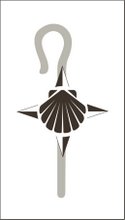
Dear Friend:
A few weeks ago I sent a letter announcing the winter pledge drive for the School of the Pilgrim. Many of you have responded kindly – some by sending in pledges, some by asking for prayers, while others have inquired about the upcoming pilgrimage to the Holy Land to be held November 12-22, 2011. For this I thank you!
Since we wrote you a few weeks ago, the Chapel Hill News has accepted for publication an essay about my most recent pilgrimage to the Holy Land (see attached). Last week I had a great lunchtime conversation with one of the campus ministries at the University of North Carolina-Chapel Hill about the School of the Pilgrim guiding their upcoming mission trip to a Navajo reservation in Arizona this May 2011. Opportunities to create pilgrimages with others groups are starting to percolate.
The School of the Pilgrim is becoming an exciting opportunity to provide an alternative way of educating and nurturing people of faith in a way that the world has either largely forgotten about or never considered before. But we cannot stop now; we need your continuing help to keep building upon the School of the Pilgrim’s progress.
Here's where you can help: please consider pledging $25, $50, $75, $100, or as much as you feel comfortable giving. You can contribute online at www.schoolofthepilgrim.com. Simply go to the menu on the left of the website, click "Contribute" and follow the instructions. Or you can send a check with a contribution to: School of the Pilgrim, P.O. Box 572, Carrboro, NC 27510. Remember that the School of the Pilgrim is a 501c3 tax-exempt organization. Your contribution by December 31, 2010 is deductible this tax year.
If you cannot give at this time, please consider ways you can support us with volunteer efforts during the next year. Meanwhile, I will continue to post insights regarding the life of a pilgrim on www.schoolofthepilgrim.blogspot.com. You can look for new images from recent pilgrimages on our website www.schoolofthepilgrim.com.
Pilgrim Peace,
Brett Webb-Mitchell
www.schoolofthepilgrim.com
P.O. Box 572
Carrboro, NC 27510

















